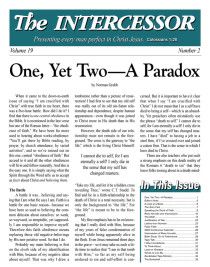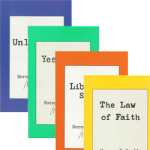
One, Yet TwoA Paradox
When it came to the down-to-earth issue of saying I am crucified with Christ with true faith in my heart, there was a five-hour battle. How did I do it? I find that there is one central obedience in the Bible. It is mentioned in the last verse but one of the Roman letterthe obedience of faith. We have been far more used to hearing about works-obedience: Youll get there by Bible reading, by prayer, by church attendance, by varied activities; and so weve missed out on this one, central obedience of faith. But acceed to it and all the other obediences will fit in and follow naturally. And this is the easy one. It is simply saying what the Spirit through the Word tells us to accept as facts about Christ and believing them.
The Battle
A battle it was believing and saying that I am what He says I am. Faith is a battle for one basic reasonbecause we have been so used to believing the common delusion about ourselves: so weak, so wayward, so temptable, yet supposedly I am responsible to improve myself. Therefore this faith obedience means replacing those old negative-believings by His new positive word. So that I do.
Probably my main believing is first on the death side of my identification with Him, because of my negative ideas about myself. That was why I drew a tombstone rather than a picture of resurrection! I had first to see that my old self was really out of its old sin-Satan relationship and dependence, despite human appearanceseven though it was joined to Christ more in His death than in His resurrection.
However, the death side of our relationship must not remain in the foreground. The cross is the gateway to the life, which is the living Christ Himself. Take my life, and let it be a hidden cross revealing Thee, wrote C.T. Studd. To find and be in a faith-relationship to the death of Christ is a total necessity, but is only the background to the life. For the life is meant to be in the foreground.
My first emphasis has to be on knowing that I really died with Him, because of my years of false condemnation of myself while being apparently alive in the flesh. Even Jesus remained three days in the graveso it may take us each a little time to realize that I am in that tomb with Him, so far as my self being enslaved to sin and self-effort is concerned. But it is important to have it clear that when I say I am crucified with Christ I do not mean that I as a self have died to being a selfwhich is an absurdity. Yet preachers often mistakenly use the phrase death to self. I cannot die to self, for I am eternally a self! I only die in the sense that my self has changed masters. I have died to having a job in a steel firm, if Ive crossed over and joined a cotton firm. That is the sense in which I have died in Christ.
There are also teachers who put such a strong emphasis on this death reality of the Romans 6 death to sin that they leave folks tossing about in a death-mind-edness. It is necessary for a time, but then out we come from the tomb!
The Truth of Galatians 2:20
So Paul continues, in his famous Galatians 2:20 statement, with nevertheless I live; yet not I, but Christ liveth in me, and we continue in our faith affirmation along with him. We say categorically, and with no ifs or buts, I am crucified with Christcut off, dead to sin, dead as the old self which was Satans dwelling place, dead to the world system in which I outwardly live. Dead, dead, dead, in His death. That I have to say before I can move on. But then I say, nevertheless I livemeaning, of course, by His resurrection out from the tomb.
But here comes the vital spot. Paul does not stop there one moment in his saying nevertheless I live. He does not leave us time to dwell on this fact of being risen, alive in Christ. He straightway corrects himselfcontradicts himself and says, No, not I, but Christ lives in me. Now this is revolutionary, radical, because though he says it is Christ living in me, he is not saying side by side with me. He is saying Christ has replaced me at my center: yet not I. Or as some have translated it yet no longer I. And that is why I use the word replacement as a key word.
Now this brings us to the very center of our Total Truth. Paul is obviously really saying, The real I in me is not Paul I, but Christ. I am really Christ in His Paul form. Yet I am that self-form, for Paul goes on to say in this same scripture, and the life which I now live in the flesh . He is still there, the redeemed Paul-I.
This is the spot where we sometimes meet with controversy. Paul is not here making the point that we are twoChrist and I. No, he is saying right out that the real I is Christ, and my I merely His agent, vessel, branch. And he states it so boldly when he puts it, I live, no not I, but Christ lives in me.
Certainly I remain, and (as we shall see later) come right back into the foreground. For Paul speaks of the self in that great Galatians 2:20 statement on three levels. I call it moving from old self (I am crucified) to no self (I live; yet not I, but Christ) to new self (the life which I now live in the flesh); so back we have come to our own selves. But we will look at that new self later. At this crisis moment we center our faith-attention on this middle no selffor this is the crux.
We do not find ourselves as the liberated, spontaneous new selves until we have first disappeared to reappear! We have to know ourselvesof course, by the inner knowing of the Spiritas replaced Is. It is I, yet not I, it is He! It really is He in place of me, and yet here I still am! What a paradox! I turn up again all right, but only on the other side of a fixed, conscious replacement. And it is the coming short of this replacement realization or indeed, opposition to itthat blocks us right the way through from that total seeing through which goes on to seeing Him only, not only in the personal, but in the universal.
I Know that I Know
We will take the risk of repetition and again go over this crisis moment of truth because of its critical importanceour conscious possessing of our possessions, our second leap of faith. We began our faith-leap by believing in our hearts and confessing with our mouths that we are crucified with Christ. Now we complete it by saying just as definitely the middle section of Pauls Galatians 2:20, Nevertheless I live; yet not I, but Christ lives in me.
I say it. Is that all? Yes, it basically is all; for faith, as we have already said, is thought thought expressed by word. As a condition of faith, something must be both available and desirable; Ill do no more than think about it until it plainly is both of these. Now to get specific: Nothing could be more desirable to me than that Christ living in me as me should be a realized fact. And Ive already seen in Gods Word that it is available. So it is available and desirablemy mind and heart have those two facts settled. So then what do I do? What I do always when I act by faith. I speak the word, which Paul calls the word of faith. I say to God, and to myself, that I am now what Paul says he and we are in this great statement of his.
I say it, whether inwardly in my spirit or vocally in words. But then, like Pilate, What I have said, I have said. That is a solemn verbal affirmation. Probably we do well to say it by confession to another, by making a date in our Bible, or whatever. It is like the purpose behind a public wedding: to make the marriage contract legally irrevocable in the sight of all men. So now this is our leap of faith. We have declared as fact what we have read of with our eyes, what has registered in our minds as plain and intelligible, and what we now choose in our heart to affirmwith no proof beyond those outer responses of my eyes, mind, emotions. That is why faith is a leapinto the yet unprovable. Available, desirable, but not yet reliable. But this is the necessary leap I personally must take. It is the one and only basic obedience of the believerthat obedience of faith: not of works or some outer activities; no, of faithwhich simply means inwardly committing myself to something (Someone) whom I now take to be total reality to me.
I have, of course, this big advantage: I already have in my new birth the saving faith which has become inner substance to me by the witness of the Spirit to the Word. So I already know Him. But this now is Total He, in me, as meHe in my formor whatever phrase we are best accustomed to. The only outer action involved in this obedience of faith is something which verbalizes this belief in my heartsomething which can be called confessing with my mouth. This is only because, for humans, contracts are valid only when there has been some public signing.
But let me again and again make this abundantly clear: Faith is substantial. Faith is the substance of the things hoped for, the evidence of the unseen. Therefore faith does not merely mean I have done my part by just believing and outwardly confessing. That is merely my faith attachment to something I desire to experience. I take foodno, food takes me: then faith is substance. I sit on a chair, yes, but the chair upholds me, not I it! Faith is substance: it produces certainty. I know whom I have believed, says Paul. I believe first and then know, and in my new birth that inner knowing of the Spirit-reality became so much everything to me that outer things are no longer the real substance I mistakenly thought they were. Now inner knowing, Spirit knowing, has become the substance that not world nor flesh nor devil can take from me.
So now in this second crisis of faith. Faith is substance. That substance does not come from us who do the believing and committing, but comes from that to which we have committed ourselves. The substance is the food, not the faith that takes it The substance is the chair, not my faith that commits myself to it. And now the substance, the certainty, is that by some means, at some timeoften immediately but not alwaysthe witnessing Spirit inwardly confirms to me that it is He, no longer I, living my life. I know. I knew fifty-one years ago, fourteen years after my first knowing of salvation, and, of course, I know the same reality today. It is as natural to me as my initial experience of salvation, only greatly enlarged and established as years have gone by. The believings of the first part of the last chapter in Johns First Epistle have dissolved into knowings by the last half, and the key word comes in the middle (1 John 5:10): He that believeth on the Son of God hath the witness in himself. Then John continues: These things have I written to you that believe that ye may know that ye have eternal life .We know that whosoever is born of God sinneth not and we know that we are of God and we know that the Son of God is come, and hath given us an understanding, that we may know Him that is true; and we are in Him that is true (vss. 13, 18, 19, 20).
So you see, we dont work up the knowing. Should you be reading this and say, Well, Ive said that word of faith; I have believed, but I cant say I know, then dont, dont try to know. Knowing does not come from self-effort; that would be back under the law of you ought again. The knowing comes from the Spirit. So what you do is to keep firmly affirming that you are what you have now said you are by faith. Your job is to maintain the affirmation. The confirmation comes from Him, and any trying or searching of your own will only insert a fog of unbelief which hinders the Spirit from giving the confirmation. But there is the confirmation.
The Perfect Pattern
What more perfect pattern are we given of what a normal person is than Jesus Himself? He continually called Himself the Son of man (His favorite and most used name for Himself) because He was affirming in no uncertain terms that He was one of us, as us indeed, was the sole representative of the human family. As Paul said, He came, made of a woman and made under the law; and Peter calls Him our example. And nothing about this ideal man (and we owe it to John that he so clearly observed and presented Him to us in His true self) is more striking than His con-stant disclaimer of doing anything or being anything of Himself. I do nothing of Myself, John quoted Him several times as saying. When questioned about His work, He said, The Son can do nothing of Himself, but what He seeth the Father do; and about His statements, As I hear, I judge; and finally, when asked by Philip to show them the Father, to whom He said He was soon going, He gave them this startling answer: He that hath seen Me hath seen the Father.
This was at the last supper, when it was His definite intention of explaining to them what His own inner (not outer) relationship was to the Father, whom they had regarded as up in heaven. He knew He was now leaving them in His physical, outer presence, to return to them as the Spirit in them; so He opened to them how He as pattern man had lived His life on earth. If youve seen Me, youve seen the Father. Then He made the relationship still more marvelously clear by adding, The words that I speak unto you I speak not of Myself; but the Father that dwelleth in Me, He doeth the works.
So that is what a normal man is: not himself, but God dwelling and working in him. Ours is not a God afar off, but God within. In light of this Jesus said, I and My Father are one; yet within that union They were twoI and My Father. And the whole point is that this is not a description of Himself as Jesus the Son of God, unique and different from us, but of Jesus as the Son of man, of whom it says in the Epistle to the Hebrews that 4 THE INTERCESSOR VOL. 19, NO. 2 He that sanctifieth and they that are sanctified are all of one, for which cause He is not ashamed to call them brethren.
Jesus Himself had prayed that we should all know this same oneness with each other: I in them, and Thou in Me, that they may be made perfect in one. And John wrote in his letter that categorical statement, As He is, so are we in this world; and If we love one another, God dwelleth in us, and His love is perfected in us; and He that dwelleth in love dwelleth in God, and God in him.
We do remain ourselvesvery much ourselves, as we shall be seeingjust as Jesus was so much Himself that the world could never ignore Him as the perfect man, whether they believed in His deity or not. Yet it is this upon which we are centering our attention: There was never a moment when He did not know that He and His Father were in an eternal union, so that who He was, was the Father being manifested in and through His Son. So our being rebuilt as whole persons must first have our union with God through His Son established, and only then do we also freely live in the easy paradox of also, being ourselves.
For many years after his retirement as General Secretary of the Worldwide Evangelization Crusade, Norman Grubb traveled extensively sharing the truth of our union with Christ. He also carried on a huge personal correspondence with individuals throughout the world. He was the author of many books and pamphlets, a number of which are available through the Zerubbabel Book Ministry. Norman lived with his daughter, Priscilla, in Fort Washington, PA. Norman P. Grubb entered the Kingdom at 98 years of age.





